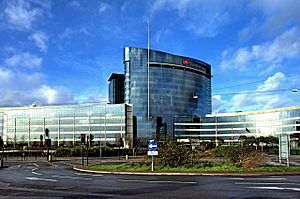Richard Sykes (microbiologist) facts for kids
Quick facts for kids
Sir
Richard Sykes
FRS FMedSci
|
|
|---|---|
| Born |
Richard Brook Sykes
7 August 1942 Huddersfield, West Yorkshire, England
|
| Education |
|
| Known for |
|
| Awards |
|
| Scientific career | |
| Fields | |
| Institutions |
|
| Chair of the Vaccine Taskforce | |
| Assumed office 2021 |
|
Sir Richard Brook Sykes is a famous British scientist who studies tiny living things called microbes. He was born on August 7, 1942. He has held many important jobs, like leading the Royal Institution and being the head of Brunel University. Since June 2021, he has been in charge of the UK's Vaccine Taskforce. This means he helped make sure people got their COVID-19 vaccines and worked on new vaccine ideas.
After finishing his university studies in 1972, Sir Richard became a leader at Glaxo. There, he helped create an important antibiotic called ceftazidime. Later, he moved to the United States to work at the Squibb Institute. He developed aztreonam, which was the first effective monobactam. He even came up with the name "monobactam" in 1981 for this new type of antibiotic.
Sir Richard also played a big part in combining major pharmaceutical companies. He helped merge Glaxo with Wellcome in 1995 to form Glaxo-Wellcome. Then, in 2000, he oversaw the merger of Glaxo Wellcome with SmithKline Beecham, creating GlaxoSmithKline, one of the world's largest drug companies. He was the chairman of this new company until 2001.
He has also been the head of Imperial College London from 2001 to 2008. He was chairman of NHS London and Imperial College Healthcare.
Contents
Early Life and Education
Richard Sykes was born on August 7, 1942, in Huddersfield, West Yorkshire, England. His parents were Eric and Muriel Mary Sykes. He went to Royds Hall Grammar school. Before finishing school, he worked as a technician in a lab that studied diseases.
After high school, he went to Paddington Technical College and Chelsea College. He then earned a top-grade degree in microbiology from Queen Elizabeth College. In 1972, he received his advanced degree (a doctorate) from the University of Bristol. His research was about how some bacteria become resistant to medicines. In 1973, he helped create a way to classify these bacteria.
Working with Glaxo and Squibb
In 1972, Sir Richard Sykes became the head of the Antibiotic Resistance Unit at Glaxo. He helped create the antibiotic ceftazidime, which fights infections. In 1977, he moved to the Squibb Institute for Medical Research in the United States. There, he worked on new types of antibiotics.
In 1979, Squibb asked him to lead research into a new group of antibiotics. He found a special substance from a bacteria called Chromobacterium violaceum. By changing this substance, he created aztreonam. This was the first "monocyclic β-lactam antibiotic." In 1981, he named this new group of antibiotics "monobactam." This new medicine could treat serious infections like gonorrhoea. It was the first monobactam approved for use in hospitals.
From 1983 to 1986, he was a vice-president at Squibb, focusing on infectious diseases. He returned to Glaxo in 1987. In 1993, he received another advanced degree, a Doctor of Science (DSc).
In 1994, while at Glaxo, he helped start the Jenner Institute. This institute focuses on researching and developing vaccines. In 1995, he led the merger of Glaxo with another company, Wellcome, to form Glaxo-Wellcome. He became the chairman of Glaxo-Wellcome in 1997. In 2000, he oversaw another big merger, combining Glaxo Wellcome with SmithKline Beecham. This created the huge company GlaxoSmithKline. He was the chairman until 2001. These mergers led to many new medicines being available. Sir Richard believed that understanding the human genome (our genetic code) would change the medicine industry.
Later Career and Leadership Roles
Leading Imperial College
In January 2001, Sir Richard became the head, or rector, of Imperial College London. He held this position until 2008. At Imperial, he was part of discussions about university fees. He also thought that science teaching in high schools needed to improve. In 2002, he suggested combining Imperial College with University College London, but this idea did not happen due to strong opposition.
UK Stem Cell Foundation
Sir Richard Sykes is the chairman of the UK Stem Cell Foundation. This organization was started in 2005. It supports research into stem cells, which are special cells that can develop into many different types of cells in the body.
Other Important Roles
From 2003 to 2005, he was a trustee for the Royal Botanic Gardens, Kew, a famous botanical garden. He also served as chairman of NHS London from 2008 to 2010. He was appointed chairman of the Royal Institution in 2010. In 2013, he became the Chancellor of Brunel University.
Vaccine Taskforce Leadership
In 2020, Sir Richard led a review of how the UK's Vaccine Taskforce was working. On June 14, 2021, he was appointed chairman of the Vaccine Taskforce. In this role, he was in charge of making sure the UK's COVID-19 vaccination program ran smoothly. This included planning for booster shots and encouraging new ideas for vaccines in the UK.
Awards and Recognitions
Sir Richard Sykes was made a knight in 1994, which means he received the title "Sir."
He has received special honorary degrees from many universities. These include Birmingham, Brunel, Edinburgh, Huddersfield, Leeds, and Newcastle. In 1998, he was elected a Fellow of the Academy of Medical Sciences.
In 2009, he received the Garrod Medal from the British Society for Antimicrobial Chemotherapy. He gave a speech called "The evolution of antimicrobial resistance: a Darwinian perspective." This speech was published in a science journal in 2010.
Images for kids



